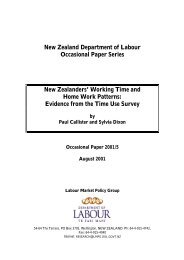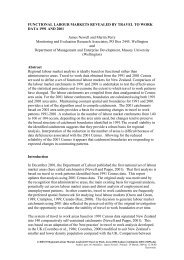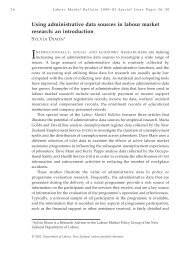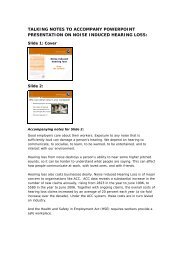Potential Output: Concepts and Measurement - Department of Labour
Potential Output: Concepts and Measurement - Department of Labour
Potential Output: Concepts and Measurement - Department of Labour
Create successful ePaper yourself
Turn your PDF publications into a flip-book with our unique Google optimized e-Paper software.
Darren Gibbs 77<br />
common procedure for estimating potential output is to fit a trend either to<br />
actual output or through its peaks. The choice between these two methods<br />
implies different views <strong>of</strong> the business cycle. The essential point is whether the<br />
gap between potential output <strong>and</strong> actual output over some cyclically neutral<br />
historical period is, on average, zero or positive. In the latter case there is<br />
presumably scope for appropriate macroeconomic policies to increase the mean<br />
level <strong>of</strong> output; but in the former case macroeconomic policies may be able to<br />
decrease the variability <strong>of</strong> output, but not increase its mean (assuming that initial<br />
macroeconomic policy settings are structurally optimal). 5<br />
The most attractive feature <strong>of</strong> these essentially theory-free estimates is their<br />
simplicity. The main univariate techniques are the trends through peaks<br />
approach, the linear time trend approach, <strong>and</strong> the Hodrick-Prescott filter<br />
approach. Discussion <strong>of</strong> the latter is reserved until later in this section where a<br />
more general application <strong>of</strong> filtering techniques is outlined.<br />
Trends through peaks approach<br />
The trends through peaks approach is one <strong>of</strong> the most popular techniques<br />
considered in the literature, <strong>and</strong> was the accepted methodology in the 1960s <strong>and</strong><br />
early 1970s. To apply this approach, seasonally adjusted output is first graphed.<br />
It is then assumed that ‘major’ peaks in the series represent output where<br />
resources in the economy are utilised at 100 percent <strong>of</strong> capacity. A straight line is<br />
drawn between each <strong>of</strong> the major peaks, <strong>and</strong> is then extrapolated (using the<br />
same slope as the line connecting the previous two peaks) beyond the last one.<br />
This line is taken to be potential output. The output gap is represented by the<br />
difference between the line representing potential output, <strong>and</strong> actual output.<br />
Because the approach results in a succession <strong>of</strong> discrete changes in a linear time<br />
trend, it is also sometimes referred to as the ‘split time trend’ method.<br />
This approach reflected the prevailing economic thinking at that time. The<br />
supply side <strong>of</strong> the economy was seen as deterministic, with changes in dem<strong>and</strong><br />
seen as the prime factor underlying observed business cycles. By focusing on the<br />
peaks <strong>of</strong> cycles, potential output was defined as the maximum possible output<br />
in a physical capacity or engineering sense; <strong>and</strong> so the calculated output gaps<br />
were almost always negative (ie actual output was below potential). As Laxton<br />
<strong>and</strong> Tetlow (1992) note, this reflected a belief that the unbridled economy tends<br />
towards inefficient outcomes, <strong>and</strong> that the goal <strong>of</strong> macroeconomic policy should<br />
be to <strong>of</strong>fset this tendency.<br />
As growth through the 1960s was relatively constant, <strong>and</strong> inflation was low<br />
<strong>and</strong> stable, the conceptual link between the output gap <strong>and</strong> inflation which had<br />
5<br />
As Laxton et al (1994) note, if the short-run Phillips curve is asymmetric, trend output<br />
will lie below potential output. In this circumstance, a policy aimed at decreasing the<br />
variability <strong>of</strong> output will also increase mean output.







![a note on levels, trends, and some implications [pdf 21 pages, 139KB]](https://img.yumpu.com/27285836/1/184x260/a-note-on-levels-trends-and-some-implications-pdf-21-pages-139kb.jpg?quality=85)






![Labour Market Trends and Outlook - 1996 [pdf 18 pages, 94KB]](https://img.yumpu.com/27285764/1/184x260/labour-market-trends-and-outlook-1996-pdf-18-pages-94kb.jpg?quality=85)

